The Industry Leading 2-Stroke Oil
For 45 years this being AMSOIL’s 2nd oldest product makes it the most scrutinized. The testimonials are so good I sometimes can’t believe the customers. Customers tell me they went from changing spark plugs yearly in equipment known to foul them, to none at all.
SABER Professional eliminates the problems that plague handheld two-stroke equipment using other oils, including hard starting, rough running, power loss and shortened service life.
Performance, Protection and Cost Reduction
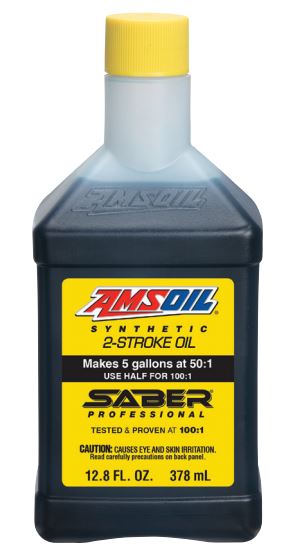
We tested SABER Professional at a 100:1 mix ratio compared to other two-stroke oils at 50:1, and the results are clear: SABER Professional dominated the competition in every area of performance. Even when using half as much oil, SABER Professional does a better job fighting carbon deposits that rob engines of power and reduce their service life. It helps landscapers, contractors and other professionals work more efficiently and cut costs.
See the PDF Saber Mixing Guide – Print it to end confusion within your staff.
Download a printable data sheet to pass to show others the merits and our warranty coverage and claims.
Check Price or BuyImproves Engine Operation & Life
SABER Professional’s high-quality synthetic base oils burn more cleanly than other synthetic and conventional base oils. It eliminates carbon deposits that lead to stuck piston rings, clogged exhaust ports and plugged spark arrestor screens. Following 300 hours of professional-use testing in ECHO* string trimmers, SABER Professional mixed at 100:1 resisted carbon better than ECHO Power Blend* XTended Life* Universal 2-Stroke Oil mixed at 50:1 (see images). For complete test results, see the ECHO 100:1 String Trimmer Technical Study (G3470).
Cuts Oil Costs
Mixing SABER Professional at 100:1 cuts oil costs by 50 percent or more while still providing unmatched protection and performance. It allows professionals the best of both worlds — reduced costs and increased protection.
Smokeless Operation
SABER Professional passes the industry-standard smoke test at the standard rich mix ratio. When mixed at the SABER Ratio, smoke is virtually undetectable. Equipment operators subjected to smoke and fumes benefit from these low-emission properties.
- Excellent lubricity and cleanliness
- Controls friction and helps prevent wear, plug fouling, ring sticking and exhaust port blocking
- Smokeless – delivers fewer emissions at 80:1 and 100:1
- Stabilizes fuel during storage
- Delivers outstanding protection and performance at lean mix ratios
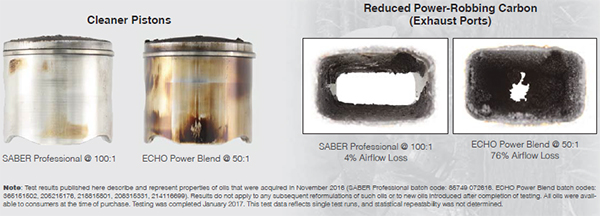
Fuel Stabilization
SABER Professional provides the additional benefit of fuel stabilization to help prevent fuel from deteriorating during storage and causing poor engine performance. There is no need to add an additional fuel stabilizer when putting equipment into seasonal storage.
APPLICATIONS
Use in all two-stroke handheld equipment where JASO FD,, ISO-L-EGD or API-TC oils are specified, including STIHL*, ECHO*, Toro*, Shindaiwa*, Craftsman*, 4-mix STIHL and Hybrid 4 Shindaiwa engines.
Use at conventional mix ratios or the SABER® Ratio,™ regardless of the mix ratio specified for the equipment. For maximum benefit, use the SABER Ratio.
| MIX | RATIO | OIL | FUEL |
| Conventional | 32:1 | 4.0 oz. | 1 U.S. GAL |
| Conventional | 40:1 | 3.2 oz. | 1 U.S. GAL |
| Conventional | 50:1 | 2.6 oz. | 1 U.S. GAL |
| SABER® Ratio™ | 80:1 | 1.6 oz. | 1 U.S. GAL |
| SABER® Ratio™ | 100:1 | 1.3 oz. | 1 U.S. GAL |
WARRANTY SECURE™
AMSOIL SABER Professional Synthetic 2-Stroke Oil is Warranty Secure, keeping your factory warranty intact. SABER Professional is a high-performance replacement for equipment manufacturer-branded products and is also backed by the AMSOIL Limited Warranty. For details, visit www.amsoil.com/warrantysecure.

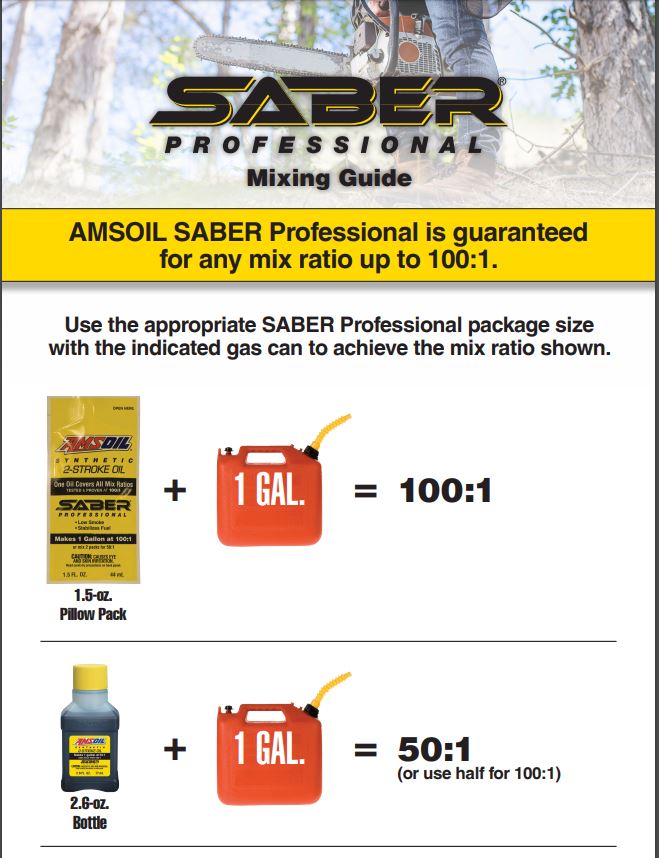
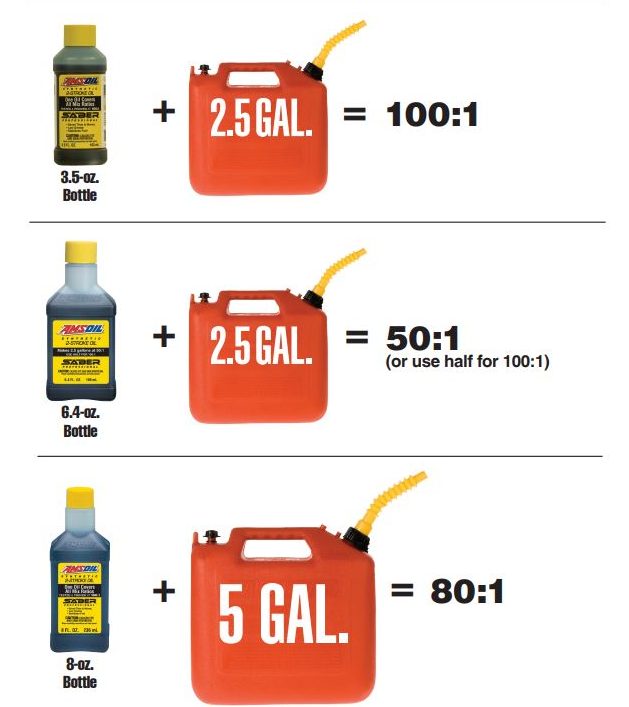
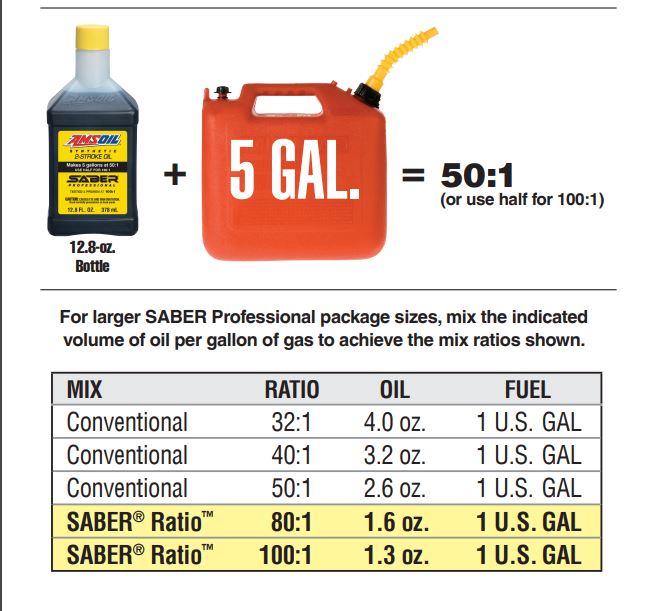
Available Packaging
There are several sizes to choose based on the containers you frequently fill. My personal suggestion for commercial use is to buy a larger size such as quarts or gallons then use them to refill the smaller bottles for measuring.
I sell the most 8 ounce size as that is perfect for 5 gallon tanks giving you a over protected 80:1. One ratio for all your equipment no matter what the OEM specifies.
ATPPK (ATPPK-EA) 1.5-Oz. Pack Each
ATPPK (ATPPK-CA) 1.5-Oz. Pack Case of 48
ATPTS (ATPTS-EA) 2.6-Oz. Bottle Each
ATPTS (ATPTS-CA) 2.6-Oz. Bottle Case of 12
ATPBA (ATPBA-EA) 3.5-Oz. Bottle Each
ATPBA (ATPBA-CA) 3.5-Oz. Bottle Case of 12
ATPSF (ATPSF-EA) 6.4-Oz. Bottle Each
ATPSF (ATPSF-CA) 6.4-Oz. Bottle Case of 12
ATPBC (ATPBC-EA) 8-Oz. Bottle Each
ATPBC (ATPBC-CA) 8-Oz. Bottle Case of 12
ATPTE (ATPTE-EA) 12.8-Oz. Bottle Each
ATPTE (ATPTE-CA) 12.8-Oz. Bottle Case of 12
ATPQT (ATPQT-EA) Quart Each
ATPQT (ATPQT-CA) Quart Case of 12
ATP1G (ATP1G-EA) Gallon Each
ATP1G (ATP1G-CA) Gallon Case of 4
ATP30 (ATP30-EA) 30-Gallon Drum Each
ATP55 (ATP55-EA) 55-Gallon Drum Each
Archive Tech –
Dan Peterson – VP. Technical Development – June 2012
E15 fuel has been approved for sale. Be Prepared!
Its impact will be felt differently by motorists and powersports enthusiasts.
 As I write this months Tech Talk, the U.S. nationwide average price for a gallon of gasoline is $3.85. On May 8, the Energy Information Administration (EIA) released a revised forecast for gas prices during the summer driving season (April through September) that predicts the average price will drop to $3.79. Thats good news for all of us, whether filling up for the daily commute or planning a longer road trip. Regardless of what vehicle you drive, its likely that maximizing fuel economy and extending engine life are high priorities. In fact, a 2011 survey by the Consumer Reports National Research Center found the age of the average car driven by respondents has increased to eight years, with 23 percent of motorists surveyed driving cars from the 1990s. And for those planning on purchasing a new or newer model, 62 percent expected their next vehicles to have better fuel economy than their previous models.
As I write this months Tech Talk, the U.S. nationwide average price for a gallon of gasoline is $3.85. On May 8, the Energy Information Administration (EIA) released a revised forecast for gas prices during the summer driving season (April through September) that predicts the average price will drop to $3.79. Thats good news for all of us, whether filling up for the daily commute or planning a longer road trip. Regardless of what vehicle you drive, its likely that maximizing fuel economy and extending engine life are high priorities. In fact, a 2011 survey by the Consumer Reports National Research Center found the age of the average car driven by respondents has increased to eight years, with 23 percent of motorists surveyed driving cars from the 1990s. And for those planning on purchasing a new or newer model, 62 percent expected their next vehicles to have better fuel economy than their previous models.
Motorists are demanding more from newer vehicles and also want their current vehicles to last longer, but new government mandates might make achieving higher efficiencies more difficult.
In April 2012, the Environmental Protection Agency (EPA) approved the sale of E15 (15 percent ethanol and 85 percent gasoline) for cars and trucks manufactured in 2001 or later. This extended by six years a 2010 waiver permitting the use of motor gasoline blends containing up to 15 percent ethanol in 2007 and newer vehicles. All other gas-powered engines, such as those on boats, snowmobiles, lawn mowers, motorcycles and off-road vehicles, are prohibited from using E15. This means that the current E10 (10 percent ethanol/90 percent gasoline) blended fuel, sold at more than 90 percent of service stations nationwide, remains the de facto choice for owners of model year 2000 and older vehicles and other gas-powered engines. The exception to this being flex-fuel vehicles compatible with E85 (85 percent ethanol/ 15 percent gasoline).
Automakers have resisted the new E15 ruling, arguing that their vehicles new and old arent designed to accommodate gasoline containing 15 percent ethanol. Service station owners have concerns about potential liability issues arising from consumers using the wrong ethanol blend and are worried about the costs of retrofitting gas pumps or installing new ones to make E15 available.
While the future of E15 is uncertain, ethanol-blended fuels are here to stay. Ethanol has been used for decades as a gasoline additive because it burns cleaner than gasoline. The downside to ethanol is its fuel economy and performance. Ethanol produces less energy than gasoline. According to the EIA, A gallon of ethanol has only two-thirds the energy of a gallon of conventional gasoline, and the number of miles traveled by a given vehicle per gallon of fuel is directly proportional to the energy contained in the fuel. In addition, studies have shown fuel systems containing plastic or rubber components can be damaged by ethanol exposure. There are also problems at the molecular level. Ethanol and gasoline do not form chemical bonds and ethanol is highly attracted to water. Even small amounts of water entering the fuel supply can break the weak ethanol-to-water bond and separate (phase separation). This suspension falls to the bottom of the fuel tank and can increase engine temperatures and cause engine damage. Less energy per gallon and phase separation are just two of the problems inherent with ethanol-blended gasoline. Smaller engines face additional maintenance and performance issues.
Because the widely available E10 can start degrading in just 30 days, the shorter shelf life of ethanol-blended gasoline vs. pure gasoline is another potential problem for small-engine operation. With equipment such as motorcycles, ATVs, boats and other less frequently used tools like chainsaws and leaf blowers, fuel may sit in the tank for a month or much longer between starts. During this time gasoline absorbs water, which leads to fuel breakdown. As gasoline degrades, gums and varnish can clog carburetors, fuel injectors and fuel filters. The result is decreased starting performance and drivability issues. Most drivers fuel their passenger vehicles more frequently than every 30 days, so gasoline breakdown issues are less common in autos and trucks. Additionally, many newer vehicles have computer sensors that make adjustments for high ethanol content, but the majority of small engines lack such technology. Fortunately for powersports enthusiasts, there are solutions to this long-term problem.
Quickshot® is designed to keep water dispersed and helps combat problems associated with ethanol-blended fuel. It also cleans deposit build-up in fuel systems and combustion chamber components. This means better performance and reduced impact from ethanol-blended fuels. We all value our free time; engines need to start on command when we get a sliver of time to get out and go.
#1 the Amsoil Quickshot SE for the fuel – prevents water separation and ethanol problems throughout the entire fuel system – Product of the year a SEMA 2010 by the way!
![]() #2 Amsoil Power Foam for instant clean-up of intake and valve carbon issues as well as an overall degreaser and parts cleaner.
#2 Amsoil Power Foam for instant clean-up of intake and valve carbon issues as well as an overall degreaser and parts cleaner.
Reviews from AMSOIL Customers
Burns clean and cool
Submitted 6 months ago
By Sledmonkey
From Minneapolis, MN
Verified Buyer
Comments about SABER Professional Synthetic 2-Stroke Oil
I am running the Saber in my 2014 KTM 300 xc-w at an 80-1 ratio. It is burning clean and cool with no fouling or exhaust spooge to speak of. I am entertained with all of the folks that say i am going to burn down unless i run 50-1 or 60-1. One more note, I am sensitive to the caustic fumes produced by some oils and do not have any burning eye issues with Saber.
Bottom Line Yes, I would recommend to a friend
I keep coming back
Submitted 6 months ago
By Mark
From Hampstead md
Verified Buyer
Comments about SABER Professional Synthetic 2-Stroke Oil
Run a small lawn service started to use amsoil in mower was so happy with the product try the two stroke great only one mix takes care of everything no smoking runs cooler and starts on first pull. Thank you amsoil !!!More Details
Bottom Line Yes, I would recommend to a friend
